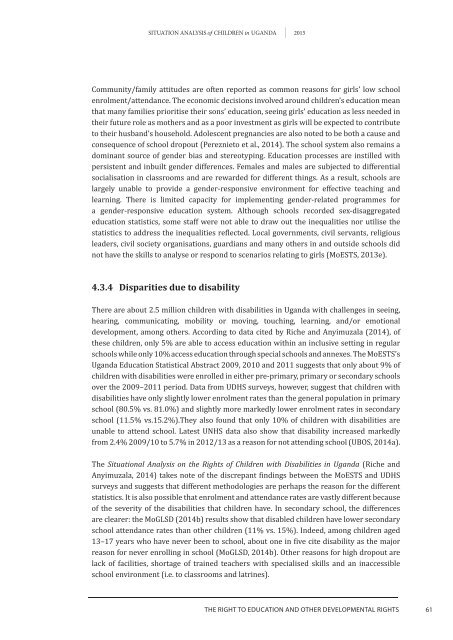Situation analySiS
1TNu802
1TNu802
You also want an ePaper? Increase the reach of your titles
YUMPU automatically turns print PDFs into web optimized ePapers that Google loves.
<strong>Situation</strong> <strong>analySiS</strong> of Children in uganda 2015Community/family attitudes are often reported as common reasons for girls’ low schoolenrolment/attendance. The economic decisions involved around children’s education meanthat many families prioritise their sons’ education, seeing girls’ education as less needed intheir future role as mothers and as a poor investment as girls will be expected to contributeto their husband’s household. Adolescent pregnancies are also noted to be both a cause andconsequence of school dropout (Pereznieto et al., 2014). The school system also remains adominant source of gender bias and stereotyping. Education processes are instilled withpersistent and inbuilt gender differences. Females and males are subjected to differentialsocialisation in classrooms and are rewarded for different things. As a result, schools arelargely unable to provide a gender-responsive environment for effective teaching andlearning. There is limited capacity for implementing gender-related programmes fora gender-responsive education system. Although schools recorded sex-disaggregatededucation statistics, some staff were not able to draw out the inequalities nor utilise thestatistics to address the inequalities reflected. Local governments, civil servants, religiousleaders, civil society organisations, guardians and many others in and outside schools didnot have the skills to analyse or respond to scenarios relating to girls (MoESTS, 2013e).4.3.4 Disparities due to disabilityThere are about 2.5 million children with disabilities in Uganda with challenges in seeing,hearing, communicating, mobility or moving, touching, learning, and/or emotionaldevelopment, among others. According to data cited by Riche and Anyimuzala (2014), ofthese children, only 5% are able to access education within an inclusive setting in regularschools while only 10% access education through special schools and annexes. The MoESTS’sUganda Education Statistical Abstract 2009, 2010 and 2011 suggests that only about 9% ofchildren with disabilities were enrolled in either pre-primary, primary or secondary schoolsover the 2009–2011 period. Data from UDHS surveys, however, suggest that children withdisabilities have only slightly lower enrolment rates than the general population in primaryschool (80.5% vs. 81.0%) and slightly more markedly lower enrolment rates in secondaryschool (11.5% vs.15.2%).They also found that only 10% of children with disabilities areunable to attend school. Latest UNHS data also show that disability increased markedlyfrom 2.4% 2009/10 to 5.7% in 2012/13 as a reason for not attending school (UBOS, 2014a).The <strong>Situation</strong>al Analysis on the Rights of Children with Disabilities in Uganda (Riche andAnyimuzala, 2014) takes note of the discrepant findings between the MoESTS and UDHSsurveys and suggests that different methodologies are perhaps the reason for the differentstatistics. It is also possible that enrolment and attendance rates are vastly different becauseof the severity of the disabilities that children have. In secondary school, the differencesare clearer: the MoGLSD (2014b) results show that disabled children have lower secondaryschool attendance rates than other children (11% vs. 15%). Indeed, among children aged13–17 years who have never been to school, about one in five cite disability as the majorreason for never enrolling in school (MoGLSD, 2014b). Other reasons for high dropout arelack of facilities, shortage of trained teachers with specialised skills and an inaccessibleschool environment (i.e. to classrooms and latrines).thE rIGht to EDUCatIoN aND othEr DEvELoPMENtaL rIGhtS61




